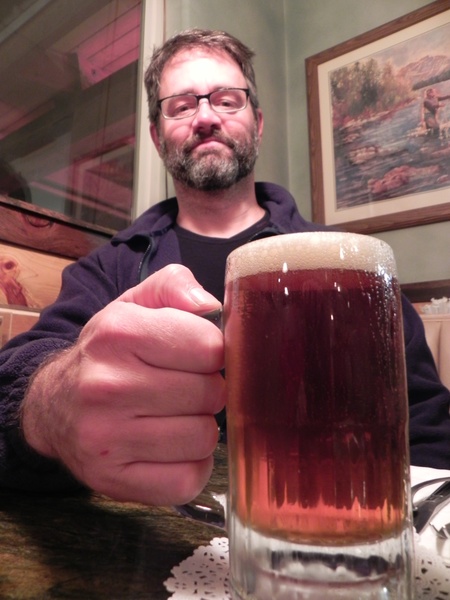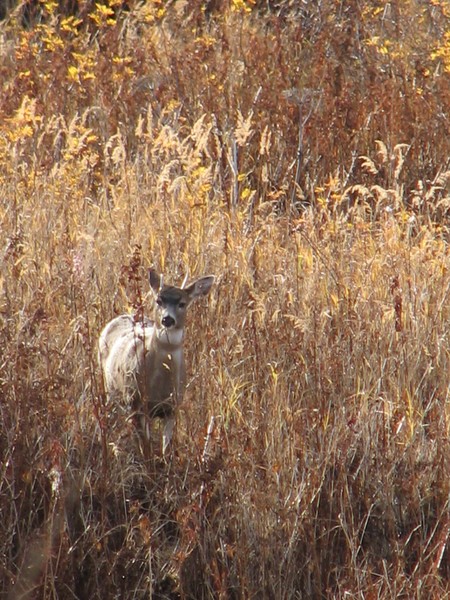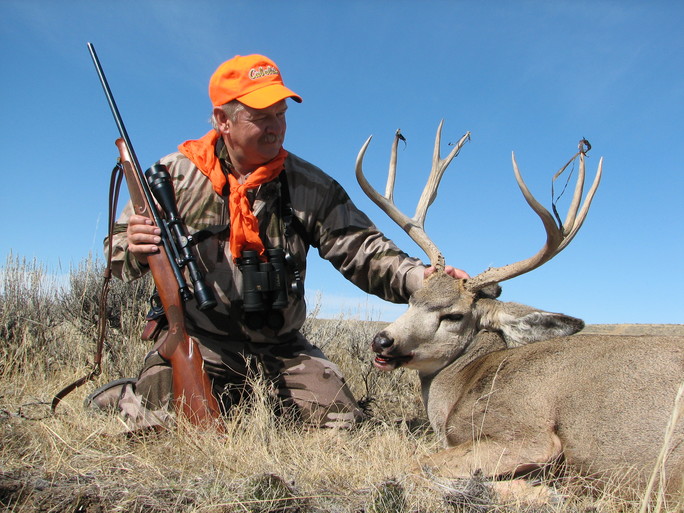13 Beers For 13 Deers
By Gary Lewis
13 Beers for 13 Deers
Thoughtful pairings of our favorite craft brews with our favorite game animals - mule deer and blacktails
By Gary Lewis and Mark Knowles
I wasn’t raised on venison, but a doctor prescribed it when I was a teenager.
“Gary, you’ll do better if you eat wild game,” the doctor said.
Try taking that prescription to a pharmacy.
My first mule deer I took with an arrow. The second fell to a bolt-action 243. We had both in the freezer at the same time and I noticed a difference in taste between the one that ate mountain browse and the other that subsisted on sage, ceanothus and bitterbrush.
Deer meat turned out to be an acquired taste. If I was going to hunt it, I was going to eat it and like it. My wife wanted to like it because our grocery bill (perceived) was greatly reduced by a surplus of neatly wrapped, hormone-free, butcher-papered packages stenciled with fancy words like backstrap, tenderloin and flank steak.
Our daughters grew up on deer, elk and antelope. We learned the better we took care of meat in the field, the better it tasted at home. Our palates grew more refined. This hit me again a couple of years ago when I sampled a young buck I shot on private land in Central Oregon. This buck had eaten garbanzo beans for most of its life. It had to be the best mule deer meat I have ever tasted. It cut like beef, but went wild on the tongue. I found myself eating it without salt or marinade, just to savor the conversion of high desert minerals and Deschutes basin waters to legumes, to pure, lean, protein.
By contrast, we had a Washington mule deer in the freezer too. This buck was taken in drought condition on wheat fields on the edge of the Palouse. It was eating clover in a field of triticale when I made the stalk. With a diet of winter wheat, rye, some clover and not enough water, the buck’s meat was tame with hints of rye. Serve it next to a bitterbrush buck and there’d be no doubt which one was on the fork.
 A few years ago, I met up with a young buck way out in the sagebrush. Expecting the sharp tang of sage and Purshia tridentata, instead, I tasted alfalfa – a ranch buck. When I looked at the map, I figured it out. That buck had been pushed off private ground when the guys in hunter orange showed up. Miles away on public land, up on the shoulder of the ridge, I’d spotted him.
A few years ago, I met up with a young buck way out in the sagebrush. Expecting the sharp tang of sage and Purshia tridentata, instead, I tasted alfalfa – a ranch buck. When I looked at the map, I figured it out. That buck had been pushed off private ground when the guys in hunter orange showed up. Miles away on public land, up on the shoulder of the ridge, I’d spotted him.
That deer we cut to half-inch steaks. Sometimes it went down wrapped in bacon with notes of alfalfa and suggestions of sage. Other times it soaked in a marinade. Our favorite marinade is made of Bragg's Amino Acids, balsamic vinegar, olive oil, beef broth, garlic and salt and pepper.
To celebrate a hunt, a hunter sometimes tips back a cold one, but there are so many choices in craft brews these days. How does a person choose the right beer to go with mule deer?
I think we start with where the deer was from, what it was eating. Let's start in the heart of mule deer country.
Utah Mule Deer
Garrett Wales is one of the founders of 10Barrel, based in Bend, Oregon. Last year, hunting in Utah, he spotted a wide buck with a big body, feeding in sagebrush just under the brow of a hill. There was a bit of snow on the ground and, when the buck stepped into an opening, Wales dropped it with a Nosler bullet.
In this part of Utah, the deer feed on forbs (weeds and wildflowers) during the growing season and turn to browse including bitterbrush and sarvisberry. Wales called this some of the sweetest mule deer meat he has tasted.
Easy pick. We like this one with 10 Barrel's Sinistor with its subtle chocolate hints and easy balance.
Pairing: S1nist0r
10barrel.com
Central Oregon Mountain Mule Deer
Mule deer in Central Oregon tend to winter out on the desert in the Fort Rock area and return to the high country in summer, ranging all the way up to the Pacific Crest Trail and even further west. When the new growth is coming up, they feed on balsamroot, prickly lettuce, twinflower, dandelions and clover. Later in the year they nibble on ceanothus, wild rose, willow, dogwood, huckleberry and Douglas fir.
A buck taken up on the shoulder of the Cascades, from the Upper Deschutes and Metolius units will have a milder flavor than a buck from the desert. Pair it with Crux Pilz for its sense of grains, grasses, herbs and hint of lemon.
Pairing: Crux Pilz
Cruxfermentation.com
Eastern Oregon High Desert Buck
Way out in Eastern Oregon, on the high benches of the Imnaha and in the breaks of the Snake River, the mule deer make their living on forbs and the new growth on twiggy browse. Then, when the summer sun cooks down the tender shoots and the weeds stop growing, the deer tend to focus on bitterbrush, sage, ceanothus, grasses and lichens. With no marinade, but accented with a little Montreal Steak Seasoning, the steak has a delicate flavor.
The pairing is SageFight with a hint of citrus, sage and juniper berries. Its dry and bitter finish is a good complement to a mule deer from Imna's Land.
Pairing: SageFight (IPA) by Deschutes Brewery
Deschutesbrewery.com
Western Oregon Blacktail
Last December I hunted in southwest Oregon with an 1840s-style muzzleloader. On the fifth day, a buck scent-checked the odor of doe-in-heat scent I'd smeared on fence posts and bushes. At 39 yards, he stopped. At the shot, he plunged away and came to rest in the blackberries. In agricultural land, this buck had grown up eating apples, pears, blackberries every fall, while eating mushrooms, lichens, forbs, vine maples and grasses in the spring.
The upfront bitterness of the Wanderlust IPA with a citrus element contrasts with the gentle flavor of the homegrown blacktail venison - golden in color like the antlers of a lowland buck.
Pairing: Wanderlust IPA by Breakside Brewery
Breakside.com
 Kodiak Island Sitka blacktail
Kodiak Island Sitka blacktail
A blacktail deer's home range does not take in very much real estate, but on Kodiak Island, the Sitka blacktail can range from 4,000 feet above sea level in the summer time to sea level when the snows deepen in November and December. Rich in organic litter, the soil of the island is infused with volcanic ash, most recently from the 1912 eruption of Mt. Novarupta.
A Sitka blacktail will move in and out of the brush to feed on kelp at low tide into April when the snow recedes. This flavor of the ocean mixed with cottonwood, Kenai birch, alder, willow, salmonberry and elderberry combines to deliver the tastiest meat of any blacktail or mule deer.
On a hunt on Kodiak, we like to say, "Something brown is going down." And that's what we're thinking when we pour a Wing-Nut Brown. This is a nice beer to finish a meal of one of the best-tasting venisons in the world.
Pairing: Kodiak Island Brewing Company Wing-Nut Brown
Kodiakbrewery.com
Western Washington
From the valley floors around Olympia and Tacoma, out to the coast and up the flanks of the Cascades, black-tailed deer are surrounded by a wealth of forbs and browse, which gives their meat a gentle complexity. Down in the riparian areas, they feed on willow, salmonberry, blackberry and cascara. Up on the slopes, the same deer might find serviceberry, red alder and, out in old burns, the red huckleberry. Springtime might find it munching on Oregon grape, dandelion and clover. If the deer walks out on an ocean beach, it will leave its tracks around fresh kelp which will finish its flavor in a unique way.
Cut through the thin cap of foam on a Bale Breaker High Camp Imperial Rye IPA and it reveals a hint of grapefruit before it mellows to a sour, lingering, dry finish.
Pairing: Bale Breaker High Camp Imperial Rye IPA
Balebreaker.com
Eastern Washington Palouse Mule Deer
Out in the Palouse, it is feast or famine for mule deer. In some areas the number of trees in a deer's home range can be counted on the fingers of one hand. To rub off the velvet they wear out fence posts. For browse, the deer find bitterbrush and rabbitbrush. Out on those long, windswept plains, they subsist on winter wheat, wheatgrass, bluegrass and oats. Balsamroot, prickly lettuce, small burnette and clover are the forbs they rely on.
Ground with an 8 percent beef fat, the meat has a milder flavor than that of sagebrush mule deer. It calls for pairing with a copper-colored ale with fruit and citrus hints.
Pairing: Born & Raised by No-Li Brewhouse
Nolibrewhouse.com
Idaho Gospel Hump Wilderness Mule Deer
High in the Salmon River watershed, up in the Gospel Hump Wilderness mule deer grow old without ever seeing a human. This is some of the most remote country in the Lower 48. The deer live in alpine, sub-alpine and forest environments, migrating all the way down to the riverbanks when the snow is deep mid-winter. In the high country they feed on forbs, mushrooms and grasses early in the summer time then switch to bitterbrush, snowbrush and willows. When snow is deep and food is scarce, they nibble at lichens and branches unreachable at other times of the year.
This too is a classic mule deer taste with perhaps more flavor than the inexperienced palate can appreciate.
Harsh to smooth. That's how this pairing finishes - a great complement to this mountain mule deer. Piney scents and mild herbals. In a can, this would be a good one to pack in the saddlebags.
Pairing: Dagger Falls IPA by Sockeye Brewing
Sockeyebrew.com
Eastern Montana Mule Deer
The Blackfeet called the Rocky Mountains the "backbone of the world." For centuries they controlled that land east of the Rockies where they lived on buffalo, elk and mule deer.
In the spring, the deer seek out pricklypear, white and purple prairieclover, phlox, coneflower, sunflower, Echinacea and other forbs. In the summer deer can find groundcover like bearberry, Oregon grape. Shrubs like serviceberry, curlleaf mountain mahogany, American plum, chokecherry and snowberry offer good eating in summer and fall. Wherever deer eat this well, they acquire the most complex and varying tastes in the venison.
Wherever a hunter connects with a mule deer in eastern Montana, from the hills around Fort Peck Lake to the breaks of the Little Bighorn, a classic pairing is Custer's Last Stout.
An oatmeal stout, it starts with a malt sweetness, exudes coffee and chocolate then disappears like the sound of a bugle at dawn. Drink it after dinner with all your friends around you and don't leave anything in the glass.
Pairing: Custer's Last Stout by Montana Brewing Company
Montanabrewingcompany.com
 Eastern Wyoming Mule Deer
Eastern Wyoming Mule Deer
Out on the east side of Wyoming, hunters find mule deer in stands of junipers and aspens and in sagebrush draws. In spring they feed on succulent, nutritious forbs like fireweed, dandelion and clover, adding grasses and shrubs in late spring. Over the summer, as grasses dry out, they shift to a diet of twiggy shrubs like curlleaf mountain mahogany, antelope bitterbrush, sagebrush, rabbitbrush, willows, and buffaloberry. If they have the opportunity, they will feed on crops like alfalfa.
On the table, these deer provide the classic taste of the well-rounded mule deer diet with a sharpness to the tastebuds that people say takes an acquired taste. A true deer lover prizes this meat and the beer
If you can find this deep dark red Belgian sour ale, sip it sparingly between mouthfuls of venison. The nose is raspberry with hints of vanilla and French oak from the barrel.
Pairing: Le Serpent Framboise (barrel aged) by Snake River Brewing
Snakeriverbrewing.com
D-Zone California Mule Deer
Archery deer seasons start early in California. A D-Zone tag might find the bowhunter up close to timberline, a mile from the nearest road or hiking trail. At this time of year, the water sources are the key to success. Here, the deer feed on broad-leafed herbaceous plants, shrubs like wedgeleaf ceanothus and manzanita, acorns, grasses and groundcovers. When the tag is filled, there will be a long pack back to the truck and that's the time to start planning the barbecue.
Cook it S-L-O-W till the meat falls off the bone. Pull it apart and apply a liberal dose of a good barbecue sauce. There's only one reason to have coleslaw - put it right on top of the pulled BBQ venison and finish your meal with a citrusy, resiny, fruity Belgian like Mischief by The Bruery made (like your deer) in California.
Pairing: Mischief (Belgian) by The Bruery
Thebruery.com
Central California Coastal Blacktail
It's habitat ranges from the coastal plains near Santa Barbara north and east out to the western slope of the Cascades from the Cascade-Sierra Nevada Range and out into the Sierra Nevada foothills where it mixes with mule deer.
This is dry country, much of it still in the grip of a tremendous drought. The deer thrive in oak savannah, chapparal, blackberries and poison oak. Their diet is heavy in acorns, twiggy browse, weeds, grasses and mushrooms.
Try this deer - unmarinated - with an accent like Justy's Jelly Pineapple Jalapeno and a bitter then sweet double IPA like Lagunitas' Hop Stoopid.
Pairing: Hop Stoopid (Imperial IPA) by Lagunitas Brewing Company
Lagunitas.com
Ruby Mountains Mule Deer
The summit of Ruby Dome reaches to 11,387 feet and the mountains range south-southwest for about 80 miles. This is one of the West's classic mule deer hunts and it takes several years to draw a rifle tag in the Rubies. Scoured by glaciers, the minerals feed the antlers of the region's mule deer.
Brewed at the same latitude, ten hours drive to the west, an APA like the Steelhead Extra Pale Ale is our pairing. Figure this beer with mule deer tacos, cheddar cheese, shredded lettuce, O'Hana salsa and lime.
In the glass it pours with a golden haze and finishes with notes of citrus and pine that recall dry Ruby winds on long afternoons.
Pairing: Steelhead Extra Pale Ale by Mad River Brewing
Madriverbrewing.com
# # #
Gary Lewis is an award-winning outdoor writer and television host. Contact Lewis at garylewisoutdoors.com
Mark Knowles is a serial entrepreneur and a principal at The Growler Guys. Visit their website at thegrowlerguys.com or contact Knowles at mark@thegrowlerguys.com
The End


